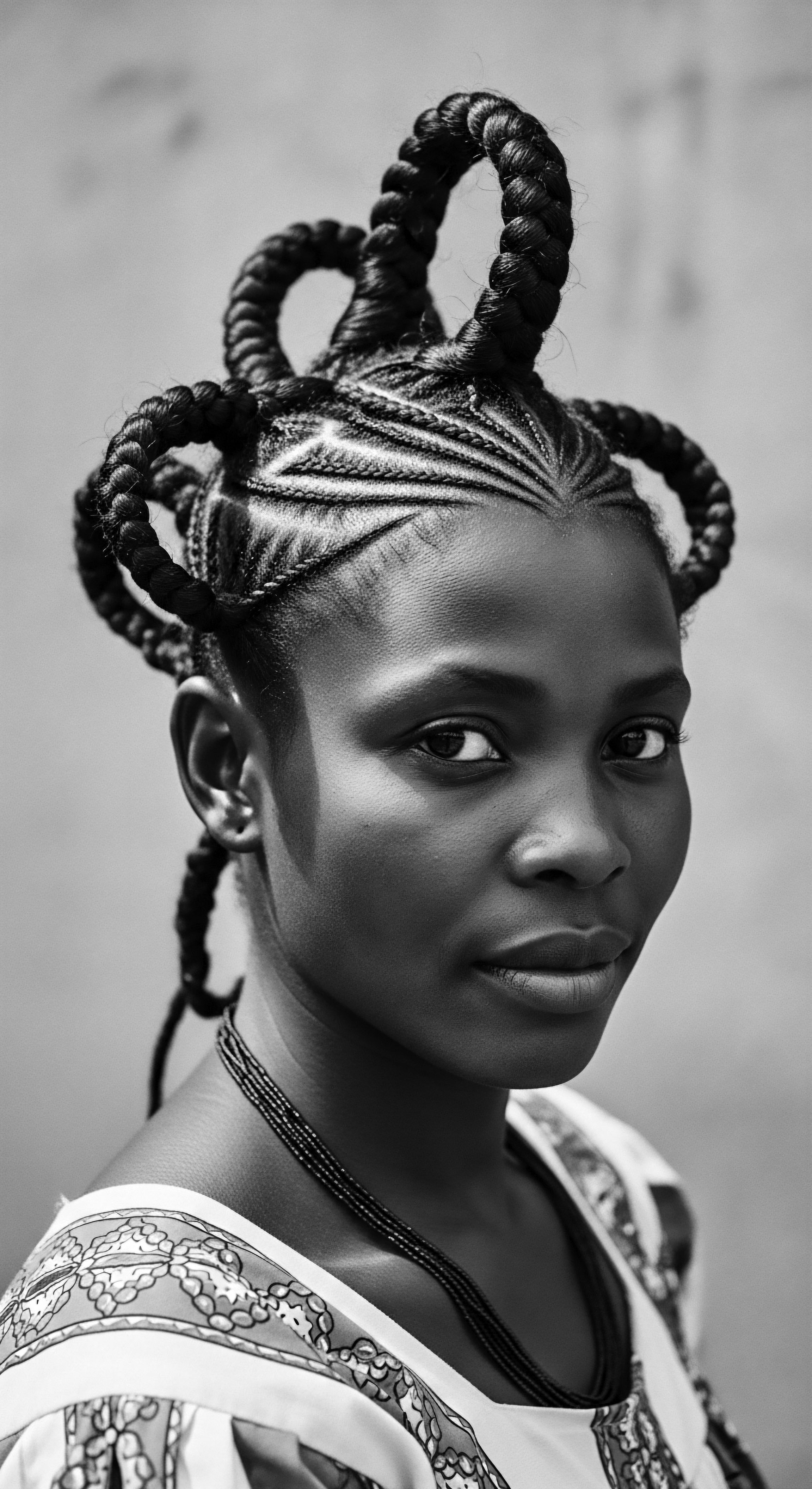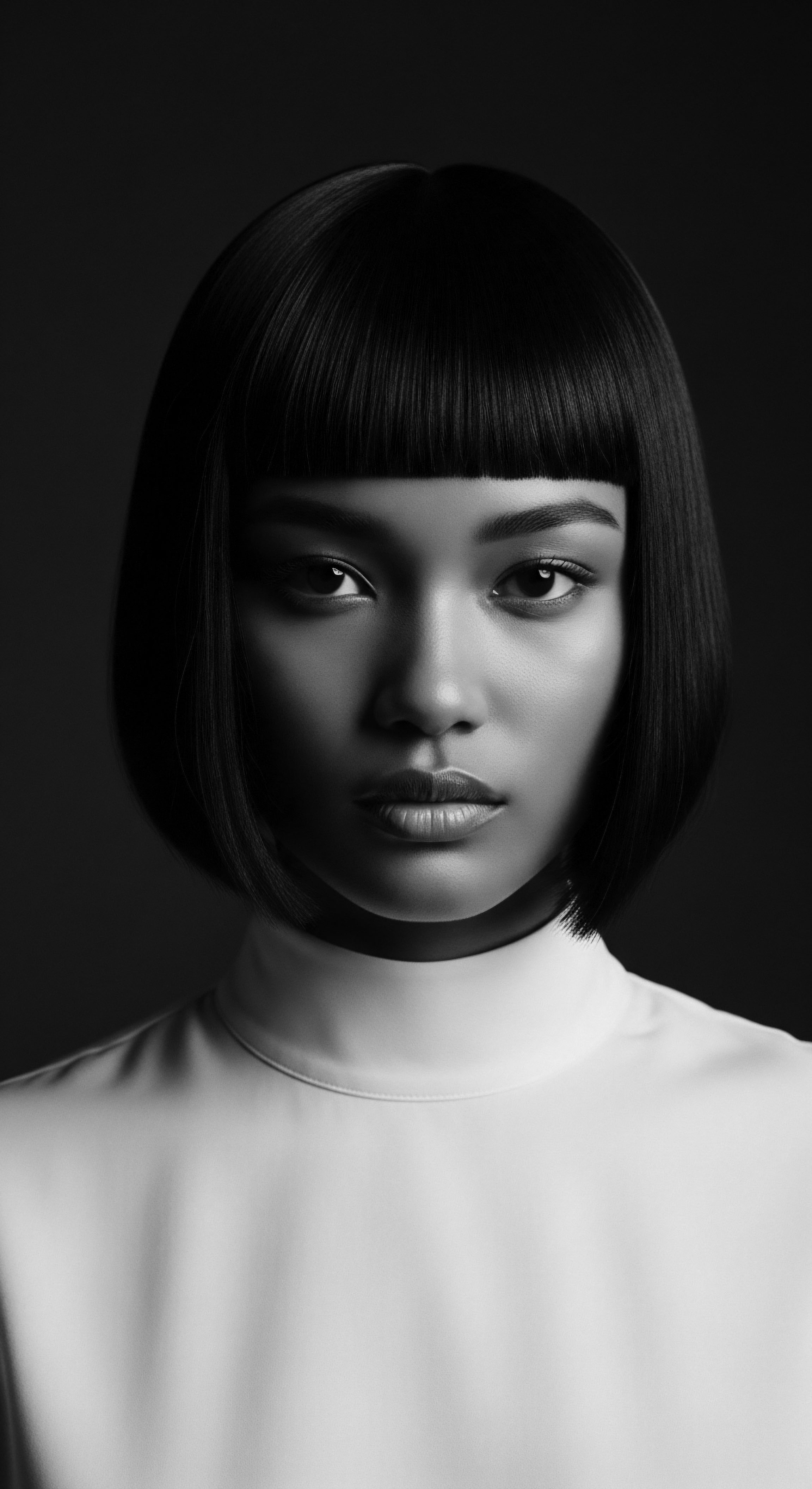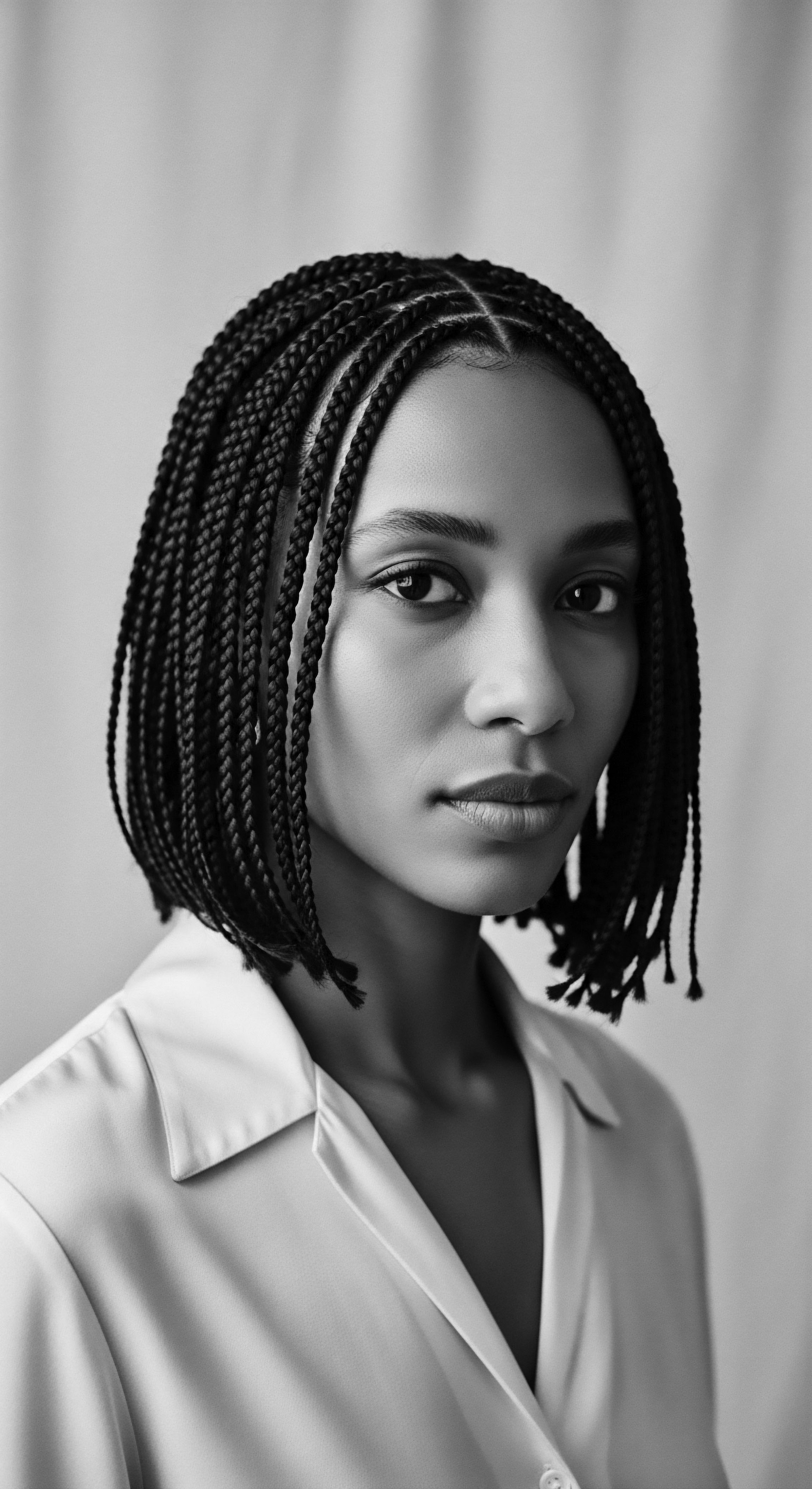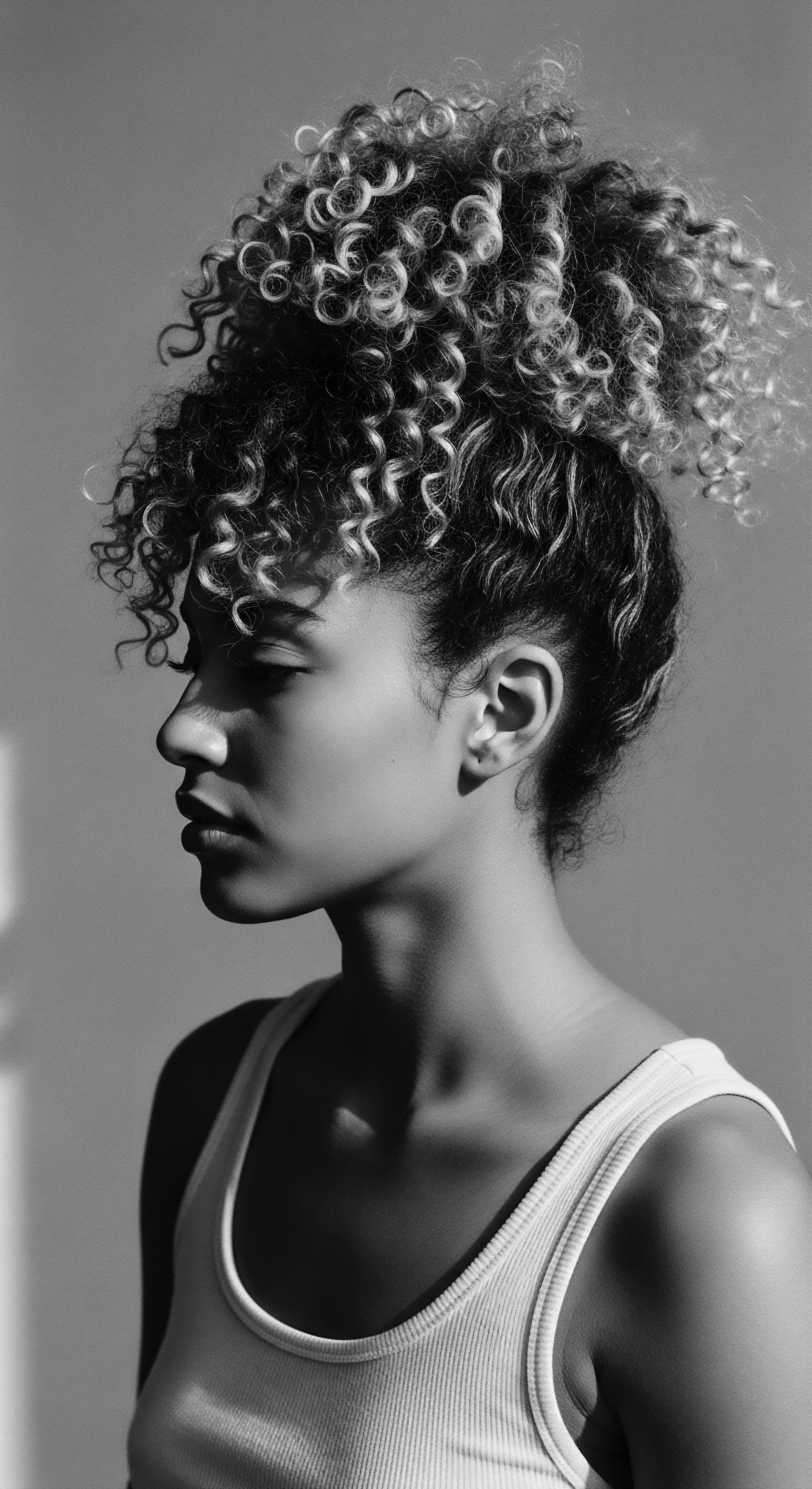
Roots
The very touch of warmth against a coil, a coil awakening to suppleness, carries within it an ancient song. It is a melody passed down through generations, not written on parchment, but held within the living memory of hands, within the very fibers of textured hair. We speak of moisturizing, not as a mere chore or a contemporary trend, but as an act deeply steeped in heritage , a practice that has, since time immemorial, spoken volumes about cultural identity for Black and mixed-race communities across the globe.
This isn’t a story of superficial beauty. It is a living archive, breathing with ancestral wisdom and the enduring spirit of a people.
Consider the biological truth of textured hair. Its unique structure, often characterized by its elliptical shape and tighter curl pattern, makes it more prone to dryness than straight hair. The twists and turns of each strand create natural points where moisture can escape, making it a thirsty companion. Yet, this inherent characteristic was not a deficiency in the eyes of our ancestors.
Instead, it was a biological reality that necessitated a sacred, intentional approach to care. This understanding, cultivated over millennia, formed the bedrock of moisturizing practices that transcended simple aesthetics. It became a language, a form of communal bond, and a silent protest.

Understanding Hair’s Ancestral Structure
The architecture of textured hair, with its inherent coil and spring, often means that the natural oils produced by the scalp, known as sebum, struggle to travel down the entire length of the hair strand. This biological reality, far from being a flaw, was recognized and responded to with remarkable ingenuity by ancient communities. Their methods of nourishing the hair worked in harmony with its structure, ensuring vitality and resilience even in harsh environments.
Ancestral practices of moisturizing textured hair transcended mere aesthetic enhancement, becoming integral to cultural identity and communal bonds.

Early Cultural Classifications of Hair and Care
Before external influences imposed new standards, African societies held diverse and fluid classifications for hair, all connected to its health and the practices sustaining it. Hair, especially when well-kept and moisturized, communicated a person’s identity , their social standing, age, marital status, or even their spiritual connection. Long, thick, neat hair often signified health, vitality, and even the ability to produce bountiful harvests or healthy children in many West African communities. The methods of care were intertwined with these meanings.
The fundamental understanding of hair’s needs was elemental. People observed. They learned from nature.
They knew, without modern chemical analyses, that certain plant-derived butters and oils provided a protective barrier, reducing moisture loss and maintaining the hair’s suppleness. This observational science, honed over generations, established core principles of textured hair care that resonate with contemporary scientific understanding.
In Ancient Egypt , for example, elaborate hair care rituals involved oils like olive and castor oil, along with honey, prized for their moisturizing and nourishing properties. These ingredients were used to keep hair lustrous and healthy, signaling status and vitality. Beyond the elite, even the daily practices of commoners revolved around understanding the hair’s needs in the dry desert climate. This early attention to hair’s physical state laid a groundwork for deeper cultural associations.

Ritual
The tending of textured hair, particularly the act of moisturizing, was never an isolated task. It was deeply embedded within the rhythms of daily life, transforming into rituals that reinforced communal ties, passed down ancestral knowledge, and served as powerful expressions of cultural continuity. These practices were living ceremonies, each application of oil, each comb through a coiled strand, a connection to generations past and a quiet assertion of self.

The Language of Lubrication
From the heart of West Africa, the karité tree, or shea tree, offered its precious butter, a substance that would come to be known as ‘women’s gold’. For centuries, women extracted this rich, fatty butter from shea nuts through meticulous traditional methods, using it not only to protect skin from harsh sun and wind but also to nourish and moisturize hair. This act of preparing and applying shea butter was more than a cosmetic routine; it was a communal activity, often performed by mothers and daughters, grandmothers and granddaughters. It became a vehicle for storytelling, for sharing wisdom about life, for fostering bonds that transcended the physical realm.
In many African communities, shea butter holds a sacred symbolism, reflecting fertility, protection, and purity. The practice of hair oiling, broadly, across many cultures, was a communal and bonding ritual, with mothers passing traditions to their daughters.
Beyond shea butter, other natural ingredients became cornerstones of moisturizing practices. Palm oil, rich in vitamins and fatty acids, was widely used in various regions, particularly in West and Central Africa. Coconut oil, indigenous to many tropical regions, played a similar vital role in communities across the Caribbean and parts of Africa, applied to hydrate and protect hair from environmental stressors. These were not simply resources; they were gifts from the earth, understood and utilized with reverence.

A Case Study The Himba of Namibia
To truly appreciate how historical moisturizing practices served cultural identity, we consider the Himba people of Namibia. Their hair traditions offer a compelling example. Himba women are renowned for their striking appearance, characterized by their hair and skin coated with a reddish paste called otjize . This paste, a mixture of ochre, butterfat, and aromatic resin, is applied daily, creating intricate styles that serve multifaceted purposes.
The application of otjize is a meticulous process, beginning in childhood. It is not merely for adornment. The butterfat component provides profound moisture and protection from the arid climate, intense sun, and insects. The reddish hue of the ochre symbolizes the earth, life, and the blood of ancestors, forging a direct, tangible link between the individual and their ancestral land and lineage.
Hairstyles themselves communicate age, marital status, and social standing. Young Himba girls wear two braids called Ozondato, symbolizing youth. As they mature, a single braid covering their face signifies readiness for marriage. Thus, the act of moisturizing with otjize is a daily reaffirmation of Himba identity , a living art form that speaks of cultural pride, connection to the natural world, and generational wisdom. This practice is a powerful, visible marker of belonging and continuity.
The daily application of otjize by Himba women is a powerful, visible marker of identity, connecting them to their ancestral land and cultural lineage.
| Agent Shea Butter |
| Primary Cultural Origin West Africa |
| Cultural Significance "Women's gold", fertility, protection, purity, communal bonding |
| Agent Palm Oil |
| Primary Cultural Origin West and Central Africa |
| Cultural Significance Nutrient-rich, used in culinary, medicinal, and cosmetic practices; symbolizes prosperity |
| Agent Coconut Oil |
| Primary Cultural Origin Coastal West Africa, Caribbean, Pacific Islands |
| Cultural Significance Nourishment, protection from sun/salt, widely accessible, part of daily wellness |
| Agent Ochre (with butterfat) |
| Primary Cultural Origin Himba, Namibia |
| Cultural Significance Connection to earth and ancestors, status marker, protection from elements |
| Agent These agents, often applied through ritualistic practices, held meanings far beyond their moisturizing properties. |

Nighttime Sanctuaries and Bonnet Wisdom
The practice of covering hair at night, often with headwraps or bonnets, also holds deep cultural resonance in textured hair heritage. While some historical bonnets in European contexts were for warmth or modesty, for Black women, these coverings gained profound significance. They became essential tools for hair preservation, protecting intricate styles from environmental damage and retaining precious moisture. During enslavement, headwraps and bonnets were, tragically, sometimes imposed to distinguish and dehumanize enslaved women.
Yet, these very coverings were reclaimed and repurposed. Black women transformed them into statements of resistance and self-expression, selecting beautiful fabrics and adorning them with beads or embroidery. The bonnet became a silent assertion of dignity, a means of preserving not just hair, but a spiritual and cultural connection to African traditions.
- Headwraps ❉ In many African regions, headwraps, known as Dukus in Ghana or Doek in Namibia, served as identifiers of wealth, ethnicity, marital status, or emotional state. Their styling could convey coded messages amongst enslaved communities.
- Hair Oiling ❉ This ancient practice, found across African and South Asian cultures, involves applying natural oils and butters to the scalp and strands. It was, and remains, a ritual of bonding, often performed by elder women on younger family members, conveying wisdom and care.
- Protective Styling ❉ Techniques like braiding and twisting, often requiring the hair to be moisturized beforehand, served to protect the hair from daily stressors and were frequently laden with social and spiritual symbolism.
These rituals, whether daily or reserved for special occasions, were acts of self-care and community care, weaving an unbroken thread of heritage through the fabric of daily life.

Relay
The history of moisturizing textured hair is a chronicle of resistance and resilience, a testament to the enduring spirit of a people who found ways to preserve their cultural identity despite profound attempts at erasure. The act of caring for one’s coils, hydrating each strand, became a deeply symbolic gesture, a quiet defiance against forces that sought to strip away dignity and connection to homeland.

How Did Hair Moisture Practices Act as Cultural Resistance?
During the transatlantic slave trade, one of the first dehumanizing acts inflicted upon enslaved Africans was the forced shaving of their heads. This was a calculated move, aiming to erase identity, sever cultural ties, and strip individuals of their spiritual power, as hair was deeply significant in African traditions, often viewed as a conduit for spiritual energy and a symbol of one’s connection to ancestors. Despite these brutal efforts, the wisdom of hair care persisted.
Enslaved communities, drawing upon collective memory, improvised with available resources. Natural oils, animal fats, and even leftover cooking grease became precious emollients for moisturizing and protecting hair from the harsh conditions of forced labor.
These practices, carried out in secret or within the confines of communal spaces, were acts of cultural preservation. The simple application of oil or grease was not just about physical comfort; it was a way to maintain a semblance of self, to hold onto a piece of what was lost. The painstaking process of detangling, conditioning, and styling became a covert social activity, strengthening familial and communal bonds. In the very folds of headscarves, sometimes used to cover their hair, enslaved Black women reportedly communicated coded messages, transforming an imposed garment into a tool for resistance and communication.

Reclaiming Narratives in the Diaspora
The Civil Rights Movement in the United States marked a powerful resurgence of natural hair as a symbol of Black pride and a rejection of Eurocentric beauty standards. The Afro hairstyle, which required proper moisture to maintain its shape and health, became a visual declaration of identity and a political statement. Icons like Angela Davis and the Black Panther Party popularized the Afro as an emblem of resistance, empowerment, and solidarity with African roots.
The need to nourish and care for this hair, often by moisturizing with natural butters and oils, became a central practice in this cultural reclamation. This re-engagement with natural textures solidified the idea that textured hair, in its inherent state, possessed inherent beauty and strength, directly challenging long-standing societal pressures for straightened hair.
The preservation of traditional hair care, including moisturizing, served as a profound act of resistance against cultural erasure and a powerful assertion of identity.
The scientific understanding of textured hair’s unique hydration needs often serves to validate these historical practices. Modern trichology confirms the importance of regular moisturizing for the elasticity and integrity of coily and curly hair structures. The ancestral application of plant-based oils and butters created occlusive layers that sealed in moisture, reducing transepidermal water loss from the scalp and hair strands, an intuitive understanding that predates scientific terminology. This confluence of ancient wisdom and contemporary science underscores the profound knowledge held by our ancestors.

How do Contemporary Insights Validate Ancestral Methods?
Consider the science behind emollients. Historical moisturizers, such as shea butter and palm oil, are rich in fatty acids and vitamins. When applied to the hair, these create a protective film, reducing water evaporation from the strand.
Modern science confirms that saturated and monounsaturated oils penetrate the hair shaft better, providing internal lubrication and helping to prevent hygral fatigue, the damage caused by repeated swelling and shrinking of hair as it absorbs and loses water. Ancestral methods, therefore, were intuitively sound, providing both external protection and internal nourishment without the benefit of laboratory analysis.
| Aspect Moisturizing Agents |
| Traditional Practices (Heritage Context) Shea butter, palm oil, coconut oil, animal fats, plant extracts |
| Modern Approaches (Scientific Context) Creams, lotions, serums; often with plant oils, silicones, humectants |
| Aspect Application Method |
| Traditional Practices (Heritage Context) Communal oiling, hand application, massage, often daily or weekly rituals, |
| Modern Approaches (Scientific Context) Product layering (LOC/LCO), direct application, scalp massages, less often communal |
| Aspect Primary Goal |
| Traditional Practices (Heritage Context) Protection from elements, spiritual connection, social status, communal bonding, basic health, |
| Modern Approaches (Scientific Context) Moisture retention, frizz control, definition, elasticity, growth stimulation, aesthetic appeal |
| Aspect Tools |
| Traditional Practices (Heritage Context) Fingers, simple combs (wood/bone), scarves, specific headwraps, |
| Modern Approaches (Scientific Context) Styling brushes, specialized combs, diffusers, bonnets, silk/satin wraps |
| Aspect The enduring principles of moisture and protection connect historical and contemporary textured hair care practices. |
The very concept of a hair “regimen,” personalized and intentional, echoes ancestral practices where hair care was not arbitrary but followed established rhythms. The knowledge passed down through generations, often through oral tradition and hands-on teaching, constitutes a significant body of ancestral wellness philosophy. This wisdom taught that hair health was intrinsically connected to overall well-being and identity, a concept that modern holistic wellness advocates now champion.
- Ingredient Intuition ❉ Ancestors understood the specific properties of plant-based ingredients through observation and experience. Shea Butter’s emollient nature and sun protection capabilities were known long before scientific classification of its fatty acids and UV filters.
- Layering for Lasting Hydration ❉ The historical use of oils and then sometimes styling with clay or other substances inadvertently created layering effects that trapped moisture, a foundational principle found in modern hair care methods like the LOC Method (Liquid, Oil, Cream).
- Scalp Health as Foundation ❉ Many ancient moisturizing rituals centered on scalp massage, recognizing the scalp as the source of hair vitality. This aligns directly with modern dermatological understanding of the scalp’s role in healthy hair growth.
These deep historical roots demonstrate that moisturizing textured hair was never a superficial act. It was a practice imbued with cultural meaning, a form of active resistance, and a celebration of enduring heritage .

Reflection
The journey through the historical practices of moisturizing textured hair reveals a profound truth ❉ it was always more than mere hydration. Each application of oil, each careful braid, each chosen headwrap, became a brushstroke on the canvas of cultural identity. The very Soul of a Strand, then, is steeped in this rich, enduring legacy. It speaks of resilience, of wisdom whispered through generations, and of an unbreakable bond between a people and their hair.
From the communal rituals of oiling in West African villages to the defiant adornment in the face of oppression, the act of moisturizing has shaped and affirmed identities. It is a story of adaptation, of finding abundance in ancestral lands, and of claiming beauty even when denied. This heritage, so meticulously preserved and practiced, informs our present understanding and invites us to approach our own hair care with a reverence that acknowledges its deep, living history. Our textured hair, therefore, becomes a tangible connection to an enduring past, a testament to the strength that lives within each coil and curl, hydrated and honored across time.

References
- Afriklens. “African Hairstyles ❉ Cultural Significance and Legacy.” 2024.
- The Kurl Kitchen. “The Cultural Significance Of Natural Hair In Different Communities.” 2024.
- The African Root. “Historical Perspectives on Hair Care and Common Styling Practices in Black Women.” 2025.
- Bebrų Kosmetika. “The Power of Hair in African Folklore ❉ Rituals and Traditions.” 2024.
- The Gale Review. “African Hairstyles – The “Dreaded” Colonial Legacy.” 2021.
- TXTUR. “The Role of Hair in Culture and Identity ❉ A Brief History.” n.d.
- The Resilient Tresses. “West African Black Hair History from the 1400s to Today.” 2024.
- Strands of Inspiration. “Exploring Black Identities through Hair.” 2023.
- Kodd Magazine. “African hair tells a story and inspires the future.” 2024.
- Substack. “Ancestral Hair Rituals to Nourish Your Hair and Soul.” 2025.
- Totnes Fashion & Textiles Museum. “Hair and Wigs in Ancient Egypt.” n.d.
- Discovering the Origins of Shea Butter. “A Journey to the Heart of Africa.” 2024.
- What Every Dermatologist Must Know About the History of Black Hair. 2023.
- STYLECIRCLE. “Origins of Beauty ❉ Hair Oiling.” n.d.
- Byrdie. “The Significance and History of Bonnets.” 2022.
- Rthvi. “Exploring Ancient Hair Care Rituals ❉ Timeless Practices for Modern Hair Wellness.” 2024.
- Helix Hair Labs. “THE HISTORY OF THE HAIR BONNET.” 2023.
- Umthi. “The Cultural Significance and Representation of Afro-Textured Hair.” 2023.
- Muse By Gaia. “The history of hair oiling.” 2023.
- Paulski Art. “The Rich History Behind Shea Butter and Its Origins.” 2024.
- Salford Students’ Union. “The Remarkable History Behind Black Hairstyles.” 2024.
- Cee Cee’s Closet NYC. “The History of Bonnets.” 2021.
- EdwardAsare – Digital Marketer. “THE ROLE OF HAIR IN ANCIENT AFRICAN CULTURES.” 2021.
- The Chief of Style. “Beauty Beyond Borders ❉ 7 Ancient Rituals for Modern Self-Love.” 2024.
- Ciafe. “Shea Butter – Explainer.” 2023.
- Know Your Hairitage. “African Culture.” n.d.
- Assendelft. “Pre-Colonial African Hairstyles ❉ A Journey Through Time and Culture.” n.d.
- Fix Salon. “Celebrating Diversity ❉ Cultural Influences on Hair.” 2024.
- Historicaleve. “Headdresses, Hairstyles, and Wigs in Ancient Egypt.” 2024.
- Team True Beauty. “The Significance and History of Black People Bonnets.” 2023.
- The History and Evolution of Hair Bonnets. “From Traditional to Modern Styles.” 2024.
- Okan Africa Blog. “The significance of hair in African culture.” 2020.
- Kinky hair – Wikipedia. n.d.
- Cécred. “Understanding Hair Oiling ❉ History, Benefits & More.” 2025.
- Hamamat Africa. “African Motherhood and Shea Butter.” 2022.
- VIORI Shampoo Bars. “5 Hair Rituals From Around the Globe.” 2022.
- Brown History. “The Bonding Ritual of Hair Oiling.” 2023.
- متجر زبدة الشيا. “What Is Shea Butter?” 2024.
